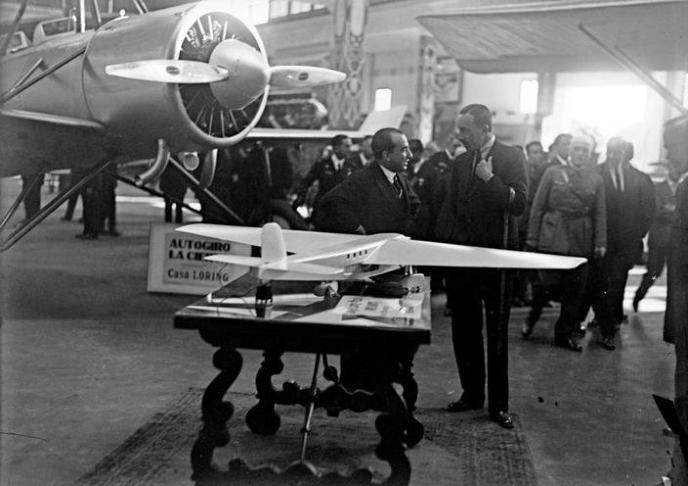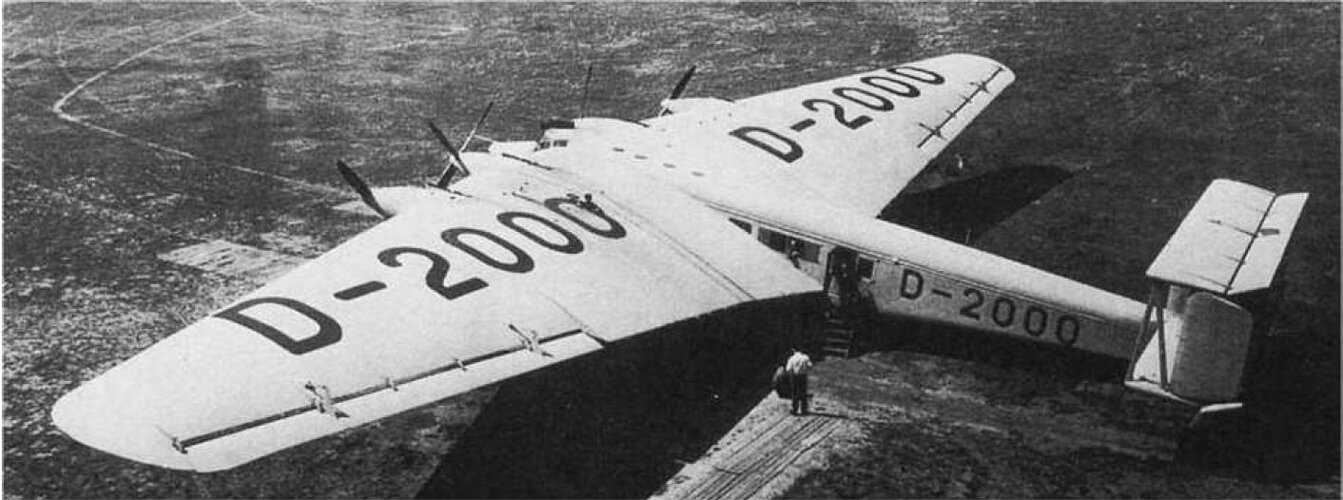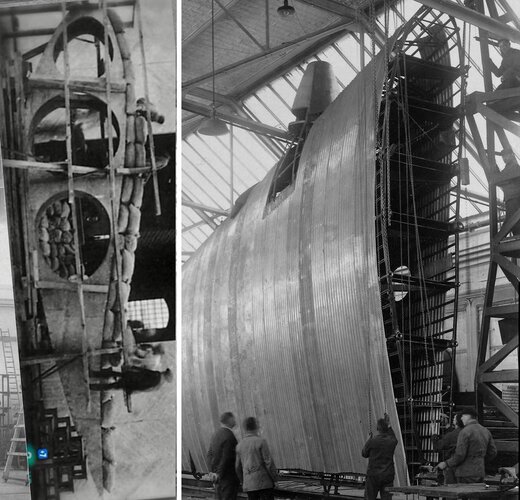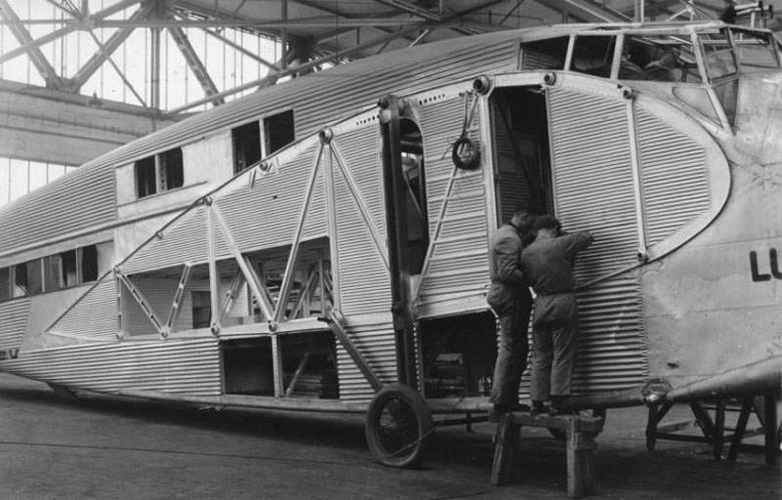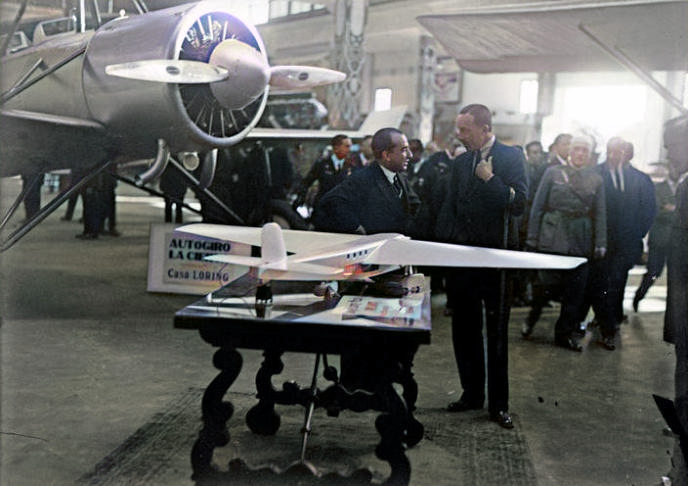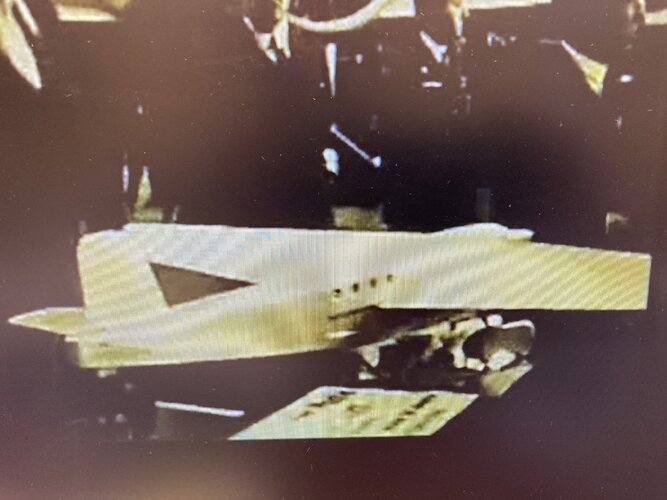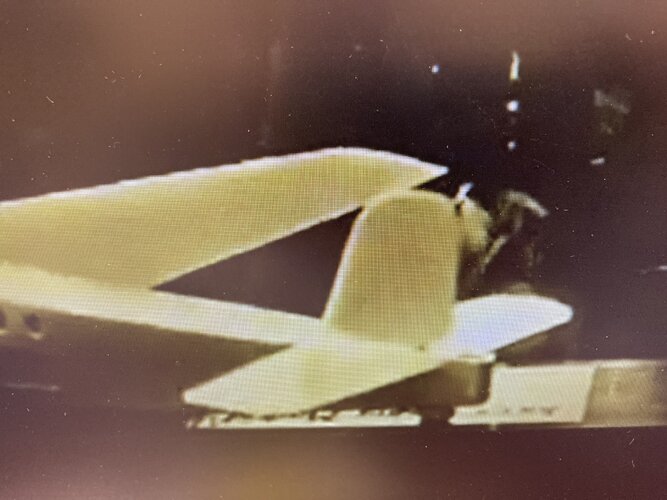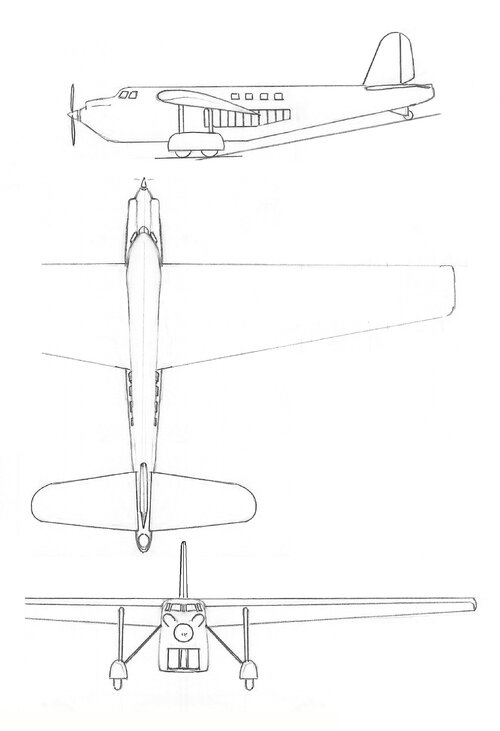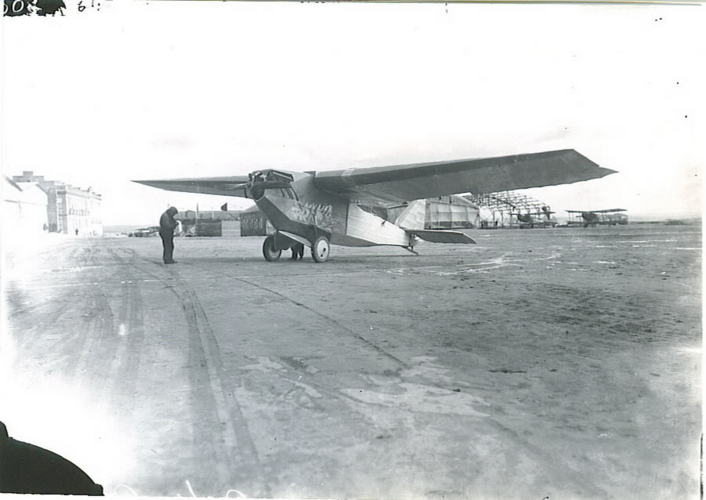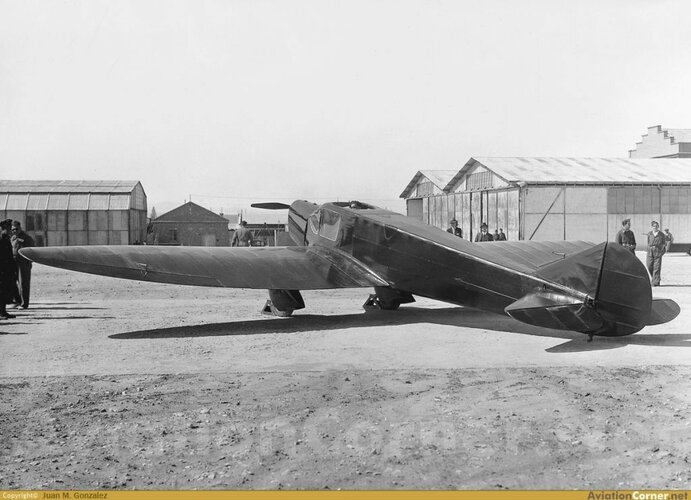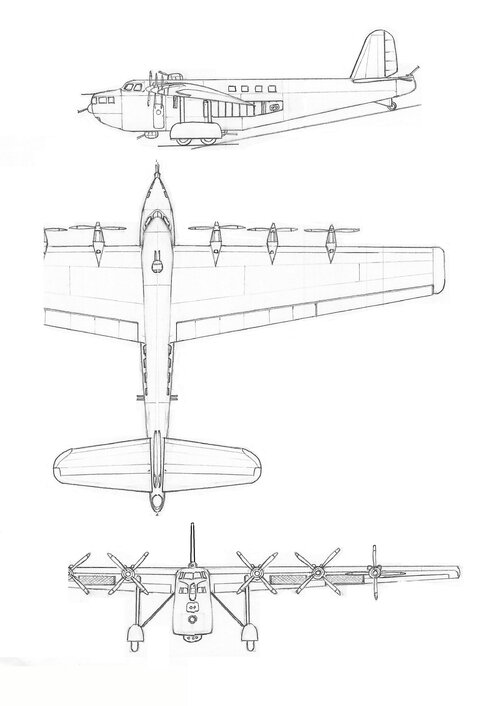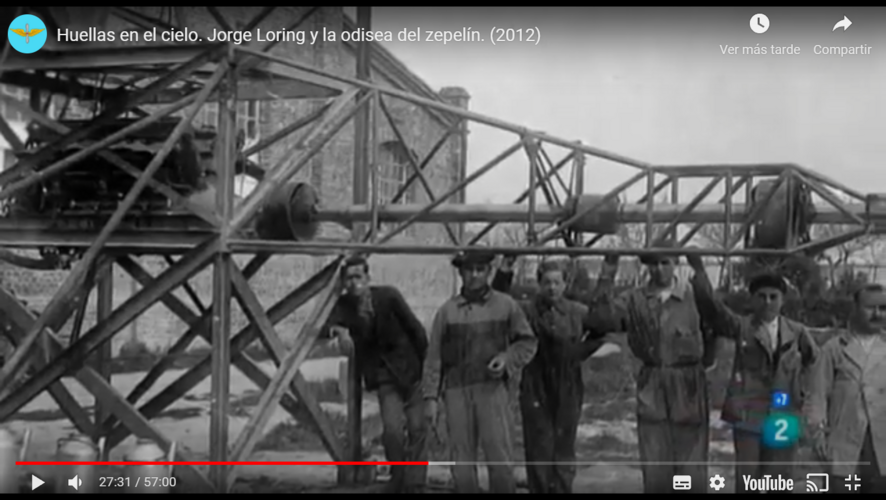You are using an out of date browser. It may not display this or other websites correctly.
You should upgrade or use an alternative browser.
You should upgrade or use an alternative browser.
Unidentified spanish project from 1929.
- Thread starter lol90oo
- Start date
- Joined
- 31 July 2013
- Messages
- 571
- Reaction score
- 1,182
It is the Loring T-III or Barrón Colonial. The only example crashed in 1932. For more details see https://www.secretprojects.co.uk/threads/barrón-and-loring-aircraft.19740/ post 8

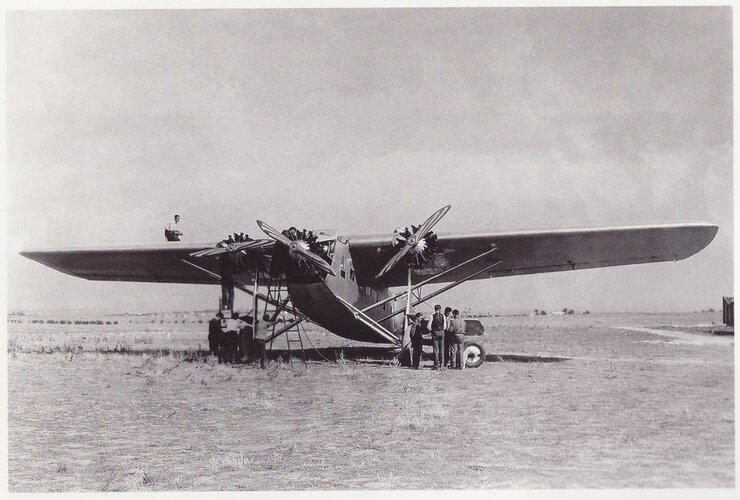
Last edited:
In my opinion it is only the project of a single-engine, long-range monoplane with extended wing similar to the record planes Fairey Long-Range Monoplane, Dewoitine D.33, Gasuden Koken and Tupolev ANT-25.
The wing design could be inspired by the Junkers monoplanes.
The wing design could be inspired by the Junkers monoplanes.
Attachments
Last edited:
- Joined
- 26 May 2006
- Messages
- 34,916
- Reaction score
- 15,789
Yes,it was a single engined monoplane,and never mentioned here ?;
- Joined
- 31 July 2013
- Messages
- 571
- Reaction score
- 1,182
Looking at the pic again I have found another use of it on this webpage, http://exposicioniberoamericanadese...0/04/25-ii-salon-de-aeronautica-nacional.html, which talks about the exposition at Seville in 1929. I have managed to zoom in on the main undercarriage units and noticed that they feature tandem wheels, on both sides, a feature not on the Loring T-III/Barrón Colonial. I apologise for my first impression that this was merely an early version of the Loring T-III/Barrón Colonial.
I attach the zoomed in image.

I attach the zoomed in image.
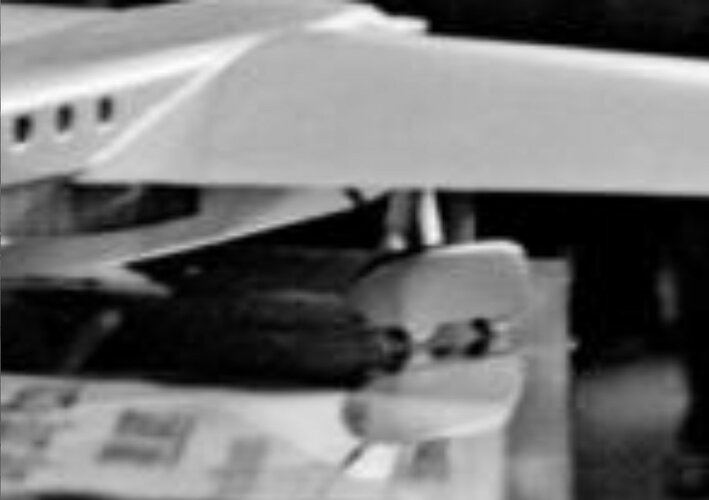
- Joined
- 31 July 2013
- Messages
- 571
- Reaction score
- 1,182
Also on the above mentioned website is this short film and our mystery plane features between 2 minutes 12 seconds and two minutes 47 seconds.
View: https://youtu.be/IYRGBqWwhk8
, Of note is an area behind the rudder which looks like, but is not necessarily, an open air gun area
, Of note is an area behind the rudder which looks like, but is not necessarily, an open air gun area
As interesting as the model is, I must say that the aircraft on the left could be more interesting still. It appears to be an autogiro, possibly made by Loring. The use of what appears to be a NACA cowling, and a long one at that, might be unusual for an autogiro, especially one dating from 1929 or so. I wonder if what we have here could be a one off version of the Cierva C.19.
A question re. the model. Is it possible that what we have here is a two-deck machine, with a row of small windows on the upper level and bay window like openings at ther lower level? I wonder about this because of a brief article in the French weekly Les Ailes of 10 October 1929 (p. 13), according to which Loring was building a six engine (4 500 hp in all) giant airliner capable of carrying up to 50 passengers in comfort.
A question re. the model. Is it possible that what we have here is a two-deck machine, with a row of small windows on the upper level and bay window like openings at ther lower level? I wonder about this because of a brief article in the French weekly Les Ailes of 10 October 1929 (p. 13), according to which Loring was building a six engine (4 500 hp in all) giant airliner capable of carrying up to 50 passengers in comfort.
Last edited:
O: Thx a lot lot lot for your infos this is defenetly it we found ww2 spanish biggest planeAs interesting as the model is, I must say that the aircraft on the left could be more interesting still. It appears to be an autogiro, possibly made by Loring. The use of what appears to be a NACA cowling, and a long one at that, might be unusual for an autogiro, especially one dating from 1929 or so. I wonder if what we have here could be a one off version of the Cierva C.19.
A question re. the model. Is it possible that what we have here is a two-deck machine, with a row of small windows on the upper level and bay window like openings at ther lower level? I wonder about this because of a brief article in the French weekly Les Ailes of 10 October 1929 (p. 13), according to which Loring was building a six engine (4 500 hp in all) giant airliner capable of carrying up to 50 passengers in comfort.
- Joined
- 25 July 2007
- Messages
- 4,299
- Reaction score
- 4,197
... It appears to be an autogiro, possibly made by Loring. The use of what appears to be a NACA cowling, and a long one at that, might be unusual for an autogiro, especially one dating from 1929 or so. I wonder if what we have here could be a one off version of the Cierva C.19...
Indeed. The placard seems to read: AUTOGIRO LA CIERVA / Casa LORING
However, since Talleres Loring license-built the Cierva C.12 (the Loring C.XII prototype), a modification of that type would be more probable than the C.19. [1] The autogiro with our model seems to have tandem cockpit with framed windscreens. If so, that too suggests a re-engined C.12 rather than a C.19. As for that new radial engine, its nine cylinders and style of push-rods suggests an Hispano-Suiza 9Qa (as fitted to the Loring T.3 trimotor).
A blog on the subject says, rather unhelpfully, that this aircraft represents "el último modelo de autogiro de La Cierva". That same blog claims that Loring built "diferentes modelos de los autogiros de Juan de La Cierva". Again, not all that helpful without knowing what other models of autogiro were built at Talleres Loring.
-- https://exposicioniberoamericanades...0/04/25-ii-salon-de-aeronautica-nacional.html
"Is it possible that what we have here is a two-deck machine, with a row of small windows on the upper level and bay window like openings at ther lower level?"
Another possibility is that the upper row of windows represent the position of bunks in a coche cama arrangement - sleeping berths being one contemporary definition of travelling by air in 'comfort'.
I get no hint of engine type or number from the angles shown of this display model. It could be fortrena's 50-passenger hexamotor from Les Ailes but who knows? As VictorXL188 noted in reply #6, there also appears to be space for a gun position aft of the rudder. That is not too surprising for Talleres Loring which seemed always to develop transport and bomber version concepts of its larger designs.
Still, I'm not sure how we got from the 1929 II Salón de Aeronáutica Nacional to "ww2 spanish biggest plane"
__________________________________________________
[1] Of course, details of Cierva's C.14, C.15, and C.16 design studies are also unaccounted for.
also there was a project called "loring b2" a six engined bomber wich production started but not finished (1935) but we d ont have any blueprints or models of this aircraft i just know that there is the civil 6engined plane and the 6engined bomber called b2 but if these arent the biggest spanish planes of that time (there is also the hispano ha400 project from 1950, a four engined heavy cargo transport wich oppening nose) well i also heard of a spanish ww1 6engined biplane bomber project but they are deffenetly the biggest i think.... It appears to be an autogiro, possibly made by Loring. The use of what appears to be a NACA cowling, and a long one at that, might be unusual for an autogiro, especially one dating from 1929 or so. I wonder if what we have here could be a one off version of the Cierva C.19...
Indeed. The placard seems to read: AUTOGIRO LA CIERVA / Casa LORING
However, since Talleres Loring license-built the Cierva C.12 (the Loring C.XII prototype), a modification of that type would be more probable than the C.19. [1] The autogiro with our model seems to have tandem cockpit with framed windscreens. If so, that too suggests a re-engined C.12 rather than a C.19. As for that new radial engine, its nine cylinders and style of push-rods suggests an Hispano-Suiza 9Qa (as fitted to the Loring T.3 trimotor).
A blog on the subject says, rather unhelpfully, that this aircraft represents "el último modelo de autogiro de La Cierva". That same blog claims that Loring built "diferentes modelos de los autogiros de Juan de La Cierva". Again, not all that helpful without knowing what other models of autogiro were built at Talleres Loring.
-- https://exposicioniberoamericanades...0/04/25-ii-salon-de-aeronautica-nacional.html
"Is it possible that what we have here is a two-deck machine, with a row of small windows on the upper level and bay window like openings at ther lower level?"
Another possibility is that the upper row of windows represent the position of bunks in a coche cama arrangement - sleeping berths being one contemporary definition of travelling by air in 'comfort'.
I get no hint of engine type or number from the angles shown of this display model. It could be fortrena's 50-passenger hexamotor from Les Ailes but who knows? As VictorXL188 noted in reply #6, there also appears to be space for a gun position aft of the rudder. That is not too surprising for Talleres Loring which seemed always to develop transport and bomber version concepts of its larger designs.
Still, I'm not sure how we got from the 1929 II Salón de Aeronáutica Nacional to "ww2 spanish biggest plane"
__________________________________________________
[1] Of course, details of Cierva's C.14, C.15, and C.16 design studies are also unaccounted for.
- Joined
- 25 July 2007
- Messages
- 4,299
- Reaction score
- 4,197
also there was a project called "loring b2" a six engined bomber wich production started but not finished (1935) ...... Still, I'm not sure how we got from the 1929 II Salón de Aeronáutica Nacional to "ww2 spanish biggest plane"
Yes, Toryu has posted images of what may well be modest Loring B.II components (or test articles):
-- https://www.secretprojects.co.uk/threads/barrón-and-loring-aircraft.19740/#post-448594
However, as noted before, the relevant dates were 1929-30, not 1935. Work stopped in 1930 following designer Eduardo Barrón's stroke. After a few years of inactivity, Talleres Loring was declared bankrupt in 1934 to allow Jorge Loring Martinez to start Aeronáutica Industrial S.A. (AISA) using his brother's money.
i do think this would look like a 6engines enlarged hispanic version of the mitsubishi ki-20 heavy bomber that was based on the ju g38also there was a project called "loring b2" a six engined bomber wich production started but not finished (1935) ...... Still, I'm not sure how we got from the 1929 II Salón de Aeronáutica Nacional to "ww2 spanish biggest plane"
Yes, Toryu has posted images of what may well be modest Loring B.II components (or test articles):
-- https://www.secretprojects.co.uk/threads/barrón-and-loring-aircraft.19740/#post-448594
However, as noted before, the relevant dates were 1929-30, not 1935. Work stopped in 1930 following designer Eduardo Barrón's stroke. After a few years of inactivity, Talleres Loring was declared bankrupt in 1934 to allow Jorge Loring Martinez to start Aeronáutica Industrial S.A. (AISA) using his brother's money.
- Joined
- 25 July 2007
- Messages
- 4,299
- Reaction score
- 4,197
i do think this would look like a 6engines enlarged hispanic version of the mitsubishi ki-20 heavy bomber that was based on the ju g38
Perhaps. But, structurally, they would seem quite different.
The attached image helps contrast the wing construction techniques used on the Barrón and Loring aircraft (going by Toryu's image) versus those employed at Dessau.
The proportions of the Barrón and Loring wing section don't bear a strong resemblance to the Junkers aircraft either - although, as you suggest, that may just a result of overall larger size.
Attachments
well to me it seems like it have similar size i found a picture of the same part mounted on the g38 the loring b2 with finished wing would be similari do think this would look like a 6engines enlarged hispanic version of the mitsubishi ki-20 heavy bomber that was based on the ju g38
Perhaps. But, structurally, they would seem quite different.
The attached image helps contrast the wing construction techniques used on the Barrón and Loring aircraft (going by Toryu's image) versus those employed at Dessau.
The proportions of the Barrón and Loring wing section don't bear a strong resemblance to the Junkers aircraft either - although, as you suggest, that may just a result of overall larger size.
Attachments
- Joined
- 25 July 2007
- Messages
- 4,299
- Reaction score
- 4,197
... finished wing would be similar
Do you mean "similar" beyond its general airfoil shape?
yes... finished wing would be similar
Do you mean "similar" beyond its general airfoil shape?
View attachment 678024... finished wing would be similar
Do you mean "similar" beyond its general airfoil shape?
the same photo but colorized.
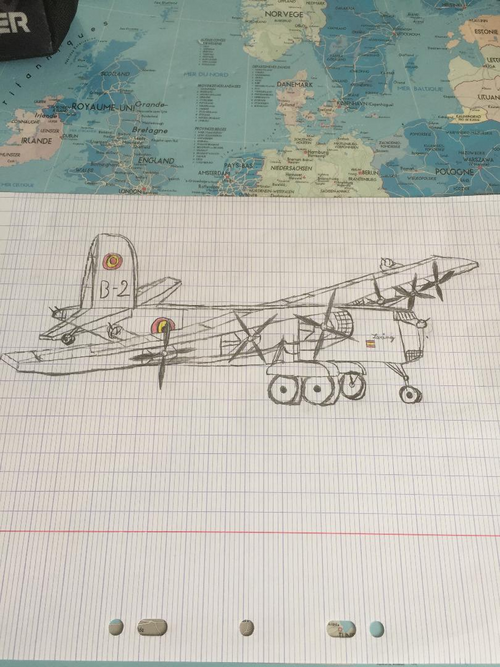
my artist impression of what it would have looked (bomber version spanish nationalist army) (sorry for the low quality draw i did my best lol)
Last edited:
Slightly different angle and one from the other side of the model from the video.
oh wow thanks a lot i can see now the rear undercarriage landing gear and also the gun turret areaSlightly different angle and one from the other side of the model from the video.
- Joined
- 29 July 2009
- Messages
- 1,770
- Reaction score
- 2,480
This is what I see from the picture and video. Of course not to scale. If its the B-II then six engines would need to be applied. I didn't see any nacelles and the straight edge in front of the cockpit looks like a valve cover for a large V-type engine
Attachments
Last edited:
wait but is there a project like this in the loring designations? also what could be the 6 engined aircraft then?This is what I see from the picture and video. Of course not to scale. If its the B-II then six engines would need to be applied. I didn't see any nacelles and the straight edge in front of the cockpit looks like a valve cover for a large V-type engine
- Joined
- 29 July 2009
- Messages
- 1,770
- Reaction score
- 2,480
The six engined aircraft is the B-II. This model appears to be a single engine high wing bomber. I assume bomber because of the tail gunner portal in the tail. The large 'window' along the bottom side of the fuselage could be a sliding door for a waist gunners position similar to a WWI Felixstowe seaplane. I don’t know it’s designation. Just speculating, but could there have been a B-III?
the edge you drew is too big if you look the first picture and also the shadow of the wing is hiding a part of the nose wich gives weird impression but i see something more like the nose of the blohm und voss 250 (ground version of 238) and some wind tunnel d ont have nacelles of the engines and also this seems way to big for a single engine aircraft and there isnt another designation further the last one he made and started in 1929 was that 6 engined bomber (he also planned a civilian version to have 50 passengers) actually i think more like a mix beetwen the ju38 and the bv250The six engined aircraft is the B-II. This model appears to be a single engine high wing bomber. I assume bomber because of the tail gunner portal in the tail. The large 'window' along the bottom side of the fuselage could be a sliding door for a waist gunners position similar to a WWI Felixstowe seaplane. I don’t know it’s designation. Just speculating, but could there have been a B-III?
- Joined
- 29 July 2009
- Messages
- 1,770
- Reaction score
- 2,480
Lol90oo you may be right. The three view is not to scale. I looked at the Loring RB and the Loring X and thought that the heritage of these two Loring aircraft could be found in the model. I took the engine and engine cowling concept from the Loring RB (which is a smaller aircraft, but of similar configuration). I looked at the Loring X for general construction (fuselage is similar in shape except its a low wing).
Attachments
yes i knew that you took the same engine of the loring BR but its front actually looks like mix beetwen ju38 and bv250 and i see that you draw very good can i ask you please to make a 6engined bomber version with this configuration plsLol90oo you may be right. The three view is not to scale. I looked at the Loring RB and the Loring X and thought that the heritage of these two Loring aircraft could be found in the model. I took the engine and engine cowling concept from the Loring RB (which is a smaller aircraft, but of similar configuration). I looked at the Loring X for general construction (fuselage is similar in shape except its a low wing).
Silencer1
That now I am the Ruler of the Queen's Navee!
- Joined
- 3 August 2009
- Messages
- 897
- Reaction score
- 582
Nice attempt! I think, that without estimating the size of airplane it couldn't be evolved further. My impression that this is a large aircraft- assuming small circle windows in an top part of fuselage and unusual "Venice blinds" at the lower part. Perhaps, not a single tractor engine in front - but the dual- or quad power plant. Something similar to Bregeut Leviathan?This is what I see from the picture and video. Of course not to scale. If its the B-II then six engines would need to be applied. I didn't see any nacelles and the straight edge in front of the cockpit looks like a valve cover for a large V-type engine
- Joined
- 29 July 2009
- Messages
- 1,770
- Reaction score
- 2,480
Silencer1, very possible. The windows at the top remind me of the Aeromarine converted F5Ls with their rail car-type ventilation system. As the hot air rises it exits the vents in the summer and in the winter they kept them closed to keep the heat in. I agree the concept was larger than anything that they had produced at the time (Loring Trimotor came in 1932). My immediate reaction was that it was a scaled up and aerodynamically refined Loring RB. The bogie wheeled landing gear also made me think that the aircraft was significantly larger and heavier. I really like the idea that the design could have been a tandem engine arrangement like the Breguet Leviathan.
I'll try an armed bomber version for kicks as Lol90oo suggested. Maybe other pictures from the exposition could arise and we'd see the front of the design.
I'll try an armed bomber version for kicks as Lol90oo suggested. Maybe other pictures from the exposition could arise and we'd see the front of the design.
only the lower windows are similar to the breguet leviathan but they said its a 6 engined monoplane with the engines in the wings with 4000kg bomb load and a passenger version that could carry 50people more like a spanish 1930 b36 wich is a mix of bv250 and ju38.Nice attempt! I think, that without estimating the size of airplane it couldn't be evolved further. My impression that this is a large aircraft- assuming small circle windows in an top part of fuselage and unusual "Venice blinds" at the lower part. Perhaps, not a single tractor engine in front - but the dual- or quad power plant. Something similar to Bregeut Leviathan?This is what I see from the picture and video. Of course not to scale. If its the B-II then six engines would need to be applied. I didn't see any nacelles and the straight edge in front of the cockpit looks like a valve cover for a large V-type engine
thanks a lot ill try to get more photos of itSilencer1, very possible. The windows at the top remind me of the Aeromarine converted F5Ls with their rail car-type ventilation system. As the hot air rises it exits the vents in the summer and in the winter they kept them closed to keep the heat in. I agree the concept was larger than anything that they had produced at the time (Loring Trimotor came in 1932). My immediate reaction was that it was a scaled up and aerodynamically refined Loring RB. The bogie wheeled landing gear also made me think that the aircraft was significantly larger and heavier. I really like the idea that the design could have been a tandem engine arrangement like the Breguet Leviathan.
I'll try an armed bomber version for kicks as Lol90oo suggested. Maybe other pictures from the exposition could arise and we'd see the front of the design.
Silencer1
That now I am the Ruler of the Queen's Navee!
- Joined
- 3 August 2009
- Messages
- 897
- Reaction score
- 582
Perhaps, the Spanish magazines of that year could give a clue to this exhibition and this model.
There is a collection of digital issues here.
And couple of Andalusian aviation magazines, with articles about Air Exhibition, where model has been presented:
And large article on Spanish about Air Exhibition.
There is a collection of digital issues here.
And couple of Andalusian aviation magazines, with articles about Air Exhibition, where model has been presented:
And large article on Spanish about Air Exhibition.
Last edited:
oh o thanks it looks so coolConcept Bomber based on previous drawing.
Silencer1
That now I am the Ruler of the Queen's Navee!
- Joined
- 3 August 2009
- Messages
- 897
- Reaction score
- 582
How fast a single-propellor aircraft became a six-propellor!Concept Bomber based on previous drawing.
Could you add the overall estimated sizes of your proposal?
In my humble opinion, it would be useful to compare it with Junkers G-38 / Mitsubishi Ki-20
its close to being twice bigger as the g-38 passenger plane could have a maximum of 34 passengers the b-2 passenger variant was set to have 50 passengers (in comfort) so actually it can have more than 50 passengers for the b-2How fast a single-propellor aircraft became a six-propellor!Concept Bomber based on previous drawing.
Could you add the overall estimated sizes of your proposal?
In my humble opinion, it would be useful to compare it with Junkers G-38 / Mitsubishi Ki-20
it looks like an engineIt is assumed that part of the transmissions of the engines, began to be built before the B.2 was canceled. Could this photo correspond to this transmission?

